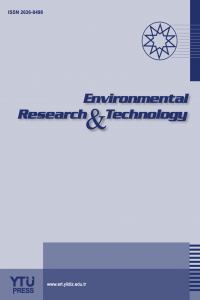Comparison of Mechanical and Physical Properties of Screed with and without Expanded Polystyrene (EPS) Particles
Comparison of Mechanical and Physical Properties of Screed with and without Expanded Polystyrene (EPS) Particles
EPS, light-weight screed, screed, strength,
___
- A. Moreira, J. António, and A. Tadeu, “Lightweight screed containing cork granules: Mechanical and hygrothermal characterization,” Cem. Concr. Compos., vol. 49, pp. 1–8, 2014, doi: 10.1016/j.cemconcomp.2014.01.012.
- B. Chen and N. Liu, “A novel lightweight concrete-fabrication and its thermal and mechanical properties,” Constr. Build. Mater., vol. 44, pp. 691–698, 2013, doi: 10.1016/j.conbuildmat.2013.03.091.
- A. Ben Fraj, M. Kismi, and P. Mounanga, “Valorization of coarse rigid polyurethane foam waste in lightweight aggregate concrete,” Constr. Build. Mater., vol. 24, no. 6, pp. 1069–1077, 2010, doi: 10.1016/j.conbuildmat.2009.11.010.
- C. Yang and R. Huang, “Approximate Strength of Lightweight Aggregate Using Micromechanics Method,” Adv Cem Based Mater, vol. 7, pp. 133–138, 1998.
- E. Yasar, C. D. Atis, A. Kilic, and H. Gulsen, “Strength properties of lightweight concrete made with basaltic pumice and fly ash,” Mater. Lett., vol. 57, no. 15, pp. 2267–2270, 2003, doi: 10.1016/S0167-577X(03)00146-0.
- T. W. Bremner, “Environmental Aspects of Concrete: Problems and Solutions,” Proc. First Russ. Conf. Concr. Reinf. Concr. Probl., no. Moscow, Russia, pp. 232–246, 2001.
- R. Sri Ravindrarajah and A. J. Tuck, “Properties of hardened concrete containing treated expanded polystyrene beads,” Cem. Concr. Compos., vol. 16, no. 4, pp. 273–277, 1994, doi: 10.1016/0958-9465(94)90039-6.
- N. H. Ramli Sulong, S. A. S. Mustapa, and M. K. Abdul Rashid, “Application of expanded polystyrene (EPS) in buildings and constructions: A review,” J. Appl. Polym. Sci., vol. 136, no. 20, pp. 1–11, 2019, doi: 10.1002/app.47529.
- D. S. Babu, K. Ganesh Babu, and T. H. Wee, “Properties of lightweight expanded polystyrene aggregate concretes containing fly ash,” Cem. Concr. Res., vol. 35, no. 6, pp. 1218–1223, 2005, doi: 10.1016/j.cemconres.2004.11.015.
- S. Doroudiani and H. Omidian, “Environmental, health and safety concerns of decorative mouldings made of expanded polystyrene in buildings,” Build. Environ., vol. 45, no. 3, pp. 647–654, 2010, doi: 10.1016/j.buildenv.2009.08.004.
- D. S. Babu, K. Ganesh Babu, and W. Tiong-Huan, “Effect of polystyrene aggregate size on strength and moisture migration characteristics of lightweight concrete,” Cem. Concr. Compos., vol. 28, no. 6, pp. 520–527, 2006, doi: 10.1016/j.cemconcomp.2006.02.018.
- TS EN 1015-11, Mortar Testing Method, Part 11. Measurement of Compressive and Flexural Tensile Strength of Mortar. Ankara: TSE, 2000.
- TS 2824 EN 1338, Concrete paving blocks - Requirements and test methods. Ankara, TURKEY: TSE, 2005.
- E. K. Akpinar and F. Koçyigit, “Thermal and mechanical properties of lightweight concretes produced with pumice and tragacanth,” J. Adhes. Sci. Technol., vol. 30, no. 5, pp. 534–553, 2016, doi: 10.1080/01694243.2015.1111832.
- H. Oktay, R. Yumrutaş, and A. Akpolat, “Mechanical and thermophysical properties of lightweight aggregate concretes,” Constr. Build. Mater., vol. 96, pp. 217–225, 2015, doi: 10.1016/j.conbuildmat.2015.08.015.
- M. Mohammad, E. Masad, T. Seers, and S. G. Al-Ghamdi, “Properties and microstructure distribution of high-performance thermal insulation concrete,” Materials (Basel)., vol. 13, no. 9, 2020, doi: 10.3390/ma13092091.
- O. Sengul, S. Azizi, F. Karaosmanoglu, and M. A. Tasdemir, “Effect of expanded perlite on the mechanical properties and thermal conductivity of lightweight concrete,” Energy Build., vol. 43, no. 2–3, pp. 671–676, 2011, doi: 10.1016/j.enbuild.2010.11.008.
- R. Demirboǧa and R. Gül, “The effects of expanded perlite aggregate, silica fume and fly ash on the thermal conductivity of lightweight concrete,” Cem. Concr. Res., vol. 33, no. 5, pp. 723–727, 2003, doi: 10.1016/S0008-8846(02)01032-3.
- R. Demirboǧa and R. Gül, “Thermal conductivity and compressive strength of expanded perlite aggregate concrete with mineral admixtures,” Energy Build., vol. 35, no. 11, pp. 1155–1159, 2003, doi: 10.1016/j.enbuild.2003.09.002.
- J. Khedari, B. Suttisonk, N. Pratinthong, and J. Hirunlabh, “New lightweight composite construction materials with low thermal conductivity,” Cem. Concr. Compos., vol. 23, no. 1, pp. 65–70, 2001, doi: 10.1016/S0958-9465(00)00072-X.
- D. K. Panesar and B. Shindman, “The mechanical, transport and thermal properties of mortar and concrete containing waste cork,” Cem. Concr. Compos., vol. 34, no. 9, pp. 982–992, 2012, doi: 10.1016/j.cemconcomp.2012.06.003.
- A. Benazzouk, O. Douzane, K. Mezreb, B. Laidoudi, and M. Quéneudec, “Thermal conductivity of cement composites containing rubber waste particles: Experimental study and modelling,” Constr. Build. Mater., vol. 22, no. 4, pp. 573–579, 2008, doi: 10.1016/j.conbuildmat.2006.11.011.
- N. Liu and B. Chen, “Experimental study of the influence of EPS particle size on the mechanical properties of EPS lightweight concrete,” Constr. Build. Mater., vol. 68, pp. 227–232, 2014, doi: 10.1016/j.conbuildmat.2014.06.062.
- Yayın Aralığı: Yılda 4 Sayı
- Başlangıç: 2018
- Yayıncı: Yıldız Teknik Üniversitesi
Zeynep BALTA, Esra BİLGİN ŞİMŞEK
Chellaiah EDWARD RAJA, Ravi PANDEESWARİ, U RAMESH
Operation cost analysis of UV-based ballast water treatment system used on a bulk carrier ship
Appraising the current state of irrigation schemes in Northern Nigeria using sustainability pillars
Nura Jafar SHANONO, Nuraddeen Mukhtar NASİDİ, Nura YAHAYA USMAN
Characterization and dye adsorption effectiveness of activated carbon synthesized from olive pomace
Fatma DENİZ, Öyküm BAŞGÖZ, Ömer GÜLER, Mehmet Ali MAZMANCI
Construction and demolition waste in Tungurahua: A case study from Ecuador
Juan Daniel CABRERA, Paola VELASCO
A process “algorithm” for C&D materials reuse through file-to-factory processes
Marina RİGİLLO, Sergio Russo ERMOLLİ, Giuliano GALLUCCİO, Sara PİCCİRİLLO, Sergio TORDO, Flavio GALDİ, Michela MUSTO
Fikret Merih KILIÇ, Hediye YORULMAZ, Sümeyye ÖZUZUN, Uğur DURAK, Serhan İLKENTAPAR, Okan KARAHAN, Cengiz ATİŞ
